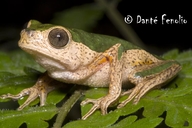|
Description
Phyllomedusa palliata is a frog that most closely resembles P. hypochondrialis and P. rohdei in size and structure. From above, the snout is rounded. In males, the snout is truncate from below. In females, the snout is slightly inclined anteroventrally. Snout-vent lengths range from 37.7 - 43.8 mm in males and 38.8 - 49.1mm in females. The parotoid glands are low and rounded, extending to the scapula. The first finger is opposable and shorter to the second. In contrast, the first toe is opposable and much longer than the second. The discs on fingers and toes are small. The forearm is slender. Dorsal skin is smooth (Duellman 1974).
P. palliata can be differentiated from P. hypochondrialis and P. rohdeli, and from most other species of Phyllomedusa, by its pale coloration below the nostrils and eye, flanks with brown flecks, irregular dashes on the posterior surfaces of the thighs, and cream and brown flecks through its venter (Duellman 1974).
In life, the dorsal surfaces and side of head above the nostrils and the middle of orbit are dark green. The side of head, below the nostrils and the middle of orbit, and flanks are cream or tan with scattered brown flecks. The iris is bronze with black reticulations. In the groin area, irregular brown dashes are scattered about the orange coloration. The anterior and posterior surfaces of the thighs are colored like the groin. The ventral surfaces are cream color with brown flecks throughout (Duellman 1974).
Distribution and Habitat
Country distribution from AmphibiaWeb's database: Bolivia, Ecuador, Peru
Phyllomedusa palliata is found in Upper Amazon Basin in Ecuador, Peru, Bolivia, and Brazil (Duellman 1974; Angulo et al. 2004; Segalla et al. 2012).
In Southeastern Peru, individuals of P. palliata have been found at night in terra firme forest, floodplain forest, and palm swamps (von May et al. 2010). Life History, Abundance, Activity, and Special Behaviors
Phyllomedusa palliata breeds in temporary pools formed in lowland forests. Females deposit eggs on the upper surface of leaves, on plants growing at the edge of pools and in areas that become inundated (Duellman 1978). Comments
In 1871, Peters originally reported a P. palliata specimen as P. hypochondrialis, but later noted that the specimen actually represented a new species, which he named Phyllomedusa palliata.
P. palliata was incorrectly identified as synonymous with Phyllomedusa tomopterna by Funkhouser in 1957, but more careful inspection showed many differences (Duellman 1974).
References
Angulo, A., Azevedo-Ramos, C., Coloma, L.A., Ron, S., Hoogmoed, M., Gascon, C., Icochea, J., Cisneros-Heredia, D. (2004). Phyllomedusa palliata. In: IUCN 2012. IUCN Red List of Threatened Species. Version 2012.2. Downloaded on 22 February 2013.
Duellman, W. E. (1974). “Taxonomic Notes on Phyllomedusa (Anura: Hylidae) from Upper Amazon Basin.” Herpetologica, 30(2), 107-108.
Duellman, W. E. (1978). ''The biology of an equatorial herpetofauna in Amazonian Ecuador.'' Miscellaneous Publications of the University of Kansas Museum of Natural History, 65, 1-352.
Segalla, M.V., Caramaschi, U., Cruz, C.A.G.; Garcia, P.C.A., Grant, T., Haddad, C.F.B, Langone, J. (2012). Brazilian amphibians – List of species. Accessible at http://www.sbherpetologia.org.br. Sociedade Brasileira de Herpetologia. Downloaded on 20 February 2013
von May, R., Jacobs, J. M., Santa-Cruz, R., Valdivia, J., Huamán, J., Donnelly, M. A. (2010). ''Amphibian community structure as a function of forest type in Amazonian Peru.'' Journal of Tropical Ecology, 26(5), 509-519.
Originally submitted by: David Wong (first posted 2013-02-13)
Edited by: Ann T. Chang & Rudolf von May (2013-02-22)Species Account Citation: AmphibiaWeb 2013 Phyllomedusa palliata <https://amphibiaweb.org/species/657> University of California, Berkeley, CA, USA. Accessed Jun 6, 2025.
Feedback or comments about this page.
Citation: AmphibiaWeb. 2025. <https://amphibiaweb.org> University of California, Berkeley, CA, USA. Accessed 6 Jun 2025.
AmphibiaWeb's policy on data use.
|
